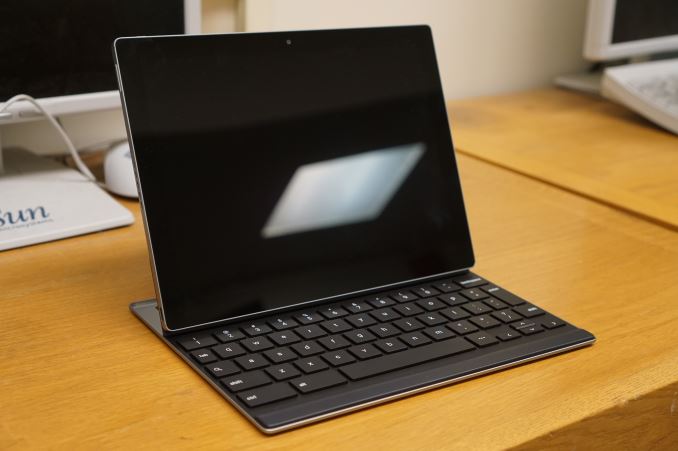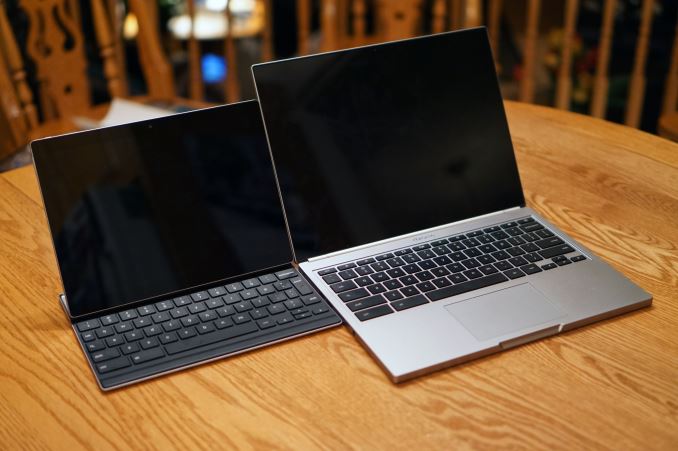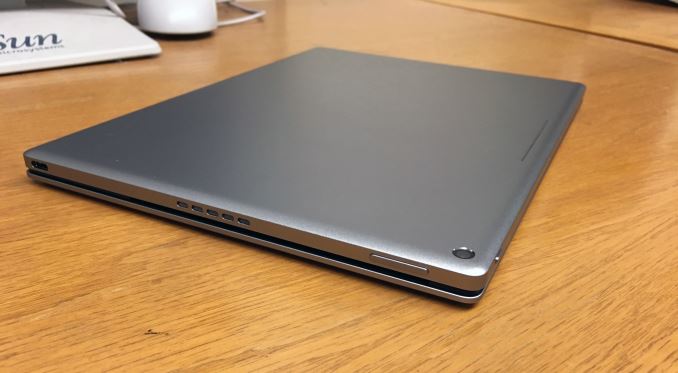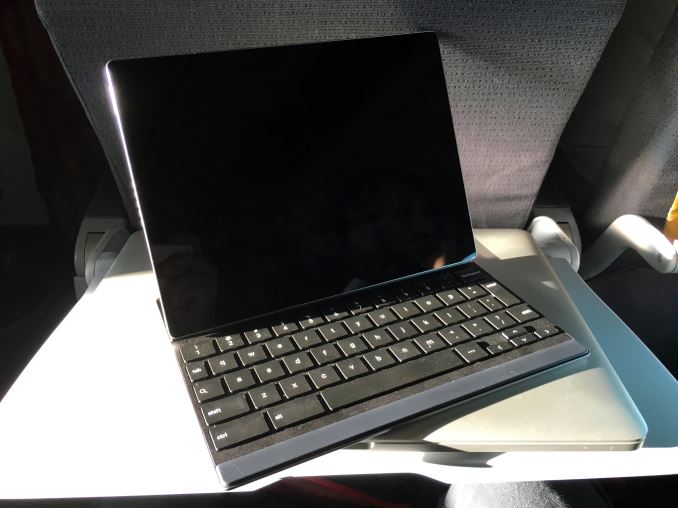The Google Pixel C Review
by Brandon Chester & Joshua Ho on January 25, 2016 8:00 AM EST
In early 2010, Google and HTC launched the Nexus One. While it was designed in a partnership between Google and HTC, it represented Google's first step into the arena of smartphone hardware design. Since that time, having a Nexus device designed and manufactured in partnership with another OEM has been something of a tradition for Google, and there have been many partnerships and products released in the six years since the Nexus One launched. While the Nexus program has remained strong, the products were technically branded by their respective manufacturers, even with Google's heavy involvement in the design process.
In 2013 Google made an exception to the trend set by the Nexus devices. The device was not an Android device, but a Chrome OS device instead. It was the original Chromebook Pixel, and it was entirely designed, branded, and supported by Google. Last year the original Chromebook Pixel received a successor in the form of the Chromebook Pixel (2015). Google was clearly testing the waters of hardware design and cooperating with companies only for hardware assembly, but they were still yet to ship an Android device that was entirely Google made and branded.
Last year's holiday launch of the Pixel C gave us the first Android device that is designed, branded, and supported by Google. It also cemented the Pixel branding as something that referred specifically to such devices, in addition to its original meaning of products which had sharp displays. The Pixel C is an Android tablet, and while it sits alongside the Google and HTC branded Nexus 9 it does not replace it. I've decided to put the Nexus 9 alongside the Pixel C in the chart below, as it's really the most relevant comparison that there is.
| Google Nexus 9 | Google Pixel C | |
| SoC | NVIDIA Tegra K1 2.3GHz Dual Core Denver |
NVIDIA Tegra X1 4 x 1.91GHz Cortex A57 4 x Cortex A53 (Disabled) |
| GPU | 192 core Kepler GPU @ 852MHz | 256 core Maxwell GPU @ ~850MHz |
| RAM | 2GB LPDDR3 | 3GB LPDDR4 |
| NAND | 16/32GB | 32/64GB |
| Display | 8.9" 2048x1536 IPS LCD | 10.2" 2560x1800 IPS LCD |
| Dimensions | 228.25 x 153.68 x 7.95mm, 436g | 242 x 179 x 7 mm, 517g |
| Camera | 8MP Rear-Facing (IMX219) 1.6MP Front-Facing (OV9760) |
8MP Rear-Facing (IMX219) 2MP Front-Facing (IMX208) |
| Battery | 25.46Wh | 34.2Wh |
| Launch OS | Android 5.0 Lollipop | Android 6.0 Marshmallow |
| Other Connectivity | 802.11a/b/g/n/ac + BT 4.1, Micro-USB 2.0 | 2x2 802.11a/b/g/n/ac + BT 4.1, USB Type-C |
| Launch Price | $399 (16GB) | $499 (32GB), $599 (64GB) $149 Keyboard |
As you can see, the Pixel C is unique in a number of ways. That definitely befits the first ever tablet designed in-house at Google, but on paper the Pixel C really feels like a breath of fresh air after a long period of Android tablets that haven’t held up from a hardware perspective. Starting with the SoC, we see the first appearance of NVIDIA's Tegra X1 in a mobile device. It previously shipped in the SHIELD Android TV so this isn’t the first Android device with the chip, but it’s the first device to use it that runs off of a battery.
We’ve covered Tegra X1 in the past, but a high level overview is that it’s an SoC with a 1.91GHz quad core Cortex A57 cluster and a rather beefy 256 core Maxwell GPU. Something important to note is that X1 does not use Heterogeneous Multi-processing, and would normally use cluster migration, which means you would either be running on the A53 cores or running on the A57 cores. In this case however the A53 cluster is actually disabled, so you're really working with a quad core A57 CPU. Paired with the SoC is either 32GB or 64GB of NAND, and 3GB of LPDDR4 memory.
Moving on to the rest of the device, the next very interesting aspect is the display. It’s a 10.2” 2560x1800 panel with an aspect ratio that is essentially equal to the square root of 2. This choice of aspect ratio is interesting because it’s the same as the ratio used for A series paper which is used in pretty much every country outside of the US and Canada. In theory, this makes the display very well suited to displaying digitized documents. Since the display is wider than a 4:3 display, it does lend itself well to landscape rather than portrait use, and that ties in well with the keyboard accessory as well.
As far as the other specs go, you get the same rear-facing 8MP sensor as the Nexus 9, with a slight resolution improvement to the front-facing camera. There's 2x2 802.11ac WiFi, along with Bluetooth 4.1 and a USB Type-C connector which has hardware, but does not offer complete software level support for USB 3.1 and alternate interface modes. Powering everything inside the tablet is a 34.2Wh battery.
Design
The Pixel line has always been notable for being entirely designed by Google, with industrial design that isn't influenced by the manufacturing and design capabilities of another company. This contrasts with Google’s strategy for their Nexus devices, which has been to partner with another manufacturer to jointly design and manufacture the device. As I mentioned before, the Pixel C is not a Chrome OS device like the existing two Pixel devices have been. Being a tablet, it seems that Google felt the Android platform would be better suited to the device than Chrome OS would be.
Left: Pixel C. Right: Chromebook Pixel (2015)
Despite Android being the software platform for the Pixel C, the hardware is unmistakably similar to the Chromebook Pixel. When looking at the outer chassis, one can see how the Pixel C could be mistaken for a smaller Chromebook Pixel. It’s built out of a single piece of aluminum, with a very squared off design. The Pixel C isn’t quite as flat on all sides as the Chromebook Pixel is, which is clearly a concession to allow for superior ergonomics when holding it. I don’t think the design is any less appealing than the Chromebook Pixel, which is to say it’s quite good. It is less striking than the very squared-off appearance of the Chromebook Pixel, but still unique among tablets.
My only complaint is that the tablet is too heavy relative to its size at 517g. This becomes an even bigger issue when the keyboard dock is thrown into the equation. It’s ridiculously heavy at 399g grams, which brings the overall mass of the package to 916g. This isn’t as heavy as the Dell Venue 10 which I heavily criticized for its excessive mass, but it’s not far off. Google has an actual reason in this case, which is that both parts of the device are made out of aluminum, but in the end it’s just not as comfortable to use as the thinner and lighter iPad Air 2, and not even close to the Galaxy Tab S2.
Something retained from the Chromebook Pixel is the light bar on the top. It lights up in Google’s signature red, blue, green, and yellow colors, and double tapping on the top of the chassis will cause the light bar to light up only a certain amount and color, which corresponds to the amount of remaining battery charge. This is still a very handy and unique feature, and it’s one of the small touches that makes a Pixel device stand out from the sameness of other tablets.
On the sides of the Pixel C you’ll find a 3.5mm audio port, a USB Type-C port, and a pair of stereo speakers. Google has made sure to note that this is a full USB 3.1 implementation, and that support for alternate interface modes such as DisplayPort and HDMI output will be coming in the future. I personally don’t believe in trying to sell a device on the basis of future updates, and at the moment the port isn’t any more functional than what you’ll get on the Nexus phones or the OnePlus Two. I suspect that this is just due to lacking support within Android, and that topic of software synergy is something I’ll be touching on more later in the review. As for the speakers, they’re not very good. I wouldn't rate them as high as the Tab S2 or any of the iPads, even though those are all down firing. The Pixel C's speakers just seem quite shrill, and yet also muffled and somewhat echoey. The only way I can describe the acoustics is that they're as if you covered just adequate speakers with a pillow and placed them several feet away.
Moving on to the front of the Pixel C, we see the intriguing 10.2” 2560x1800 display surrounded by a symmetrical bezel. The display lends itself more to landscape use even though it’s not as wide as 16:10 Android tablets, and this ties in with the keyboard dock which is used in the landscape orientation and magnetically connects to the front or back of the tablet. I’ll be talking about the Pixel C’s keyboard dock in a later section of the review, but as far as the design of it goes it’s made to fit perfectly with the Pixel C. The bottom is made of aluminum, and the primary keys are all of the same size and travel distance as the Chromebook Pixel. Google has had to shrink some of the keys on the edges in order to fit them into a keyboard that matches the 10.2” display area, but in my experience this hasn’t posed any serious issues apart from the enter key being difficult to press. As you can see above, the size also makes it well suited to more cramped circumstances, such as working when on airplanes or on the terribly small desks in some lecture halls.
In the end, the Pixel C is as well designed and constructed as the Chromebook Pixel, and it rivals the best devices on the market in that regard. The aluminum chassis is sturdy, and there are no seams or visible screws. Google’s small touches like the light bar and tapping on the top to view your battery charge are also really nice additions, and they help it to stand out from other tablets, while also making it feel very Googley. That being said, having used the iPad Air 2 and the Galaxy Tab S2 makes it very clear to me how much heavier the Pixel C is, and it’s simply not as comfortable to use for long periods of time. The fact that you may often be using it with the keyboard dock can help mitigate this, but that only applies if you buy the keyboard and intend to use it frequently. Keeping the keyboard dock with you ends up increasing the mass significantly as well, and it gets to the point that you need to think about whether you’re willing to carry around something that is more like a small laptop than a tablet in terms of its size and mass. If you’re intent on buying the Pixel C and the keyboard to use it as a 2-in-1 then I think you’ll be fine with the Pixel C, but if you’re hoping for something that you’ll be comfortable carrying around as a standalone tablet you should definitely find some way to try it out to see if it’s manageable.













122 Comments
View All Comments
ImSpartacus - Wednesday, January 27, 2016 - link
You're paying for something that "just works". You'd be surprised at how attractive that is for a lot of people that are simply incapable of using modern tech.So you can either stick your fingers in your ears and demand that everyone spend years of their life becoming experts in modern tech, or you can realize that there's some money to be made. Apple is in the business of making money.
Alexey291 - Saturday, January 30, 2016 - link
No offence to your and your expertness. But do you honestly think that it takes "a few years" to become an expert of playing with touchscreen devices?Oh boy...
jbelkin - Monday, January 25, 2016 - link
Well, not ignorant, just an economy that only supports 9% of buyers being able to afford the stnadard bearer.Vlad_Da_Great - Tuesday, January 26, 2016 - link
@jbelkin. EU are not as shallow and easy to manipulate as their USA counterparts. Also, biggest % of iPhone purchases in USA are done from people over 60y old. If you look around the globe the second biggest country with huge engineering population (India) has no interest in the iPhone.Asians on the other side love magic, that is what APPL is good of selling.
vanilla_gorilla - Tuesday, January 26, 2016 - link
That's mostly related to income. The vast majority of those people would much prefer an Apple device if they could afford it. Most Android devices are incredible cheap devices.the_comment_guy - Tuesday, January 26, 2016 - link
What are you talking about? Apple hasn't been ableto open stores in India due to their laws requiring 30% of their components to be sourced from small to medium enterprises: that's why they've barely made a dent in the Indian phone market. Despite this, Apple's sales in India have been increasing every year. If India relaxes its backwards laws, and Apple is allowed to open their own stores, Apple sales will explode.Alexey291 - Saturday, January 30, 2016 - link
Sure the sales have grown in india. Shame about the sales in the rest of the world.Essentially last quarter's sales have been propped up by the Chinese and Indian sales growth. The rest of the world however...
akdj - Thursday, February 4, 2016 - link
Rest of the world? As in North, South America and a dozen European countries? Apple's BLOWN their OWN records out of the water with iOS device sales. iPads are down ...unfortunately for Apple, they're built too well! Seriously, as I've owned each iPad ...we use them with our business and both original and iPad 2s are still BOTH working & battery life on the first iPad continues beating a dozen hours watching movies. Eight browsing or a good 25-30 listening to music, screen off!My iPad '2' purchased on launch day and the kids use it all the time. No issues ...they're replied amid don't die. Apple is continuing support for older devices. Kicking their own selves in the sack! Or ...maybe not.
While geeks like me justify with my job, personal business and personal 'wants' the purchase of each new iPad that drops, and because of each gen's phenomenal updates. iPad 3 aside, which I owned until 4 dropped - iPad 3 left on Craigslist the following day with its updated performance so obvious. The 'new' iPad 3, IMHO, is the only anomaly to the updates and performance increases, display/resolution updates, shaving weight, maintaining battery life and dramatically boosting its 'guts', sensors, display accuracy and smaller but significant user bonuses like the A/G display stack and their lamination & out of factory calibration ....make each iPad, in my line of work, play & education priceless! Original to iPad 2, the difference was/is obvious. 2-->3, 'Retina' on the iPad, a complete game changer. Oops, same engine as the iPad 2, 4 times the resolution, drop the 4 with its Apple designed SoC monster A8X --- exponentially bettering the iPad w/Retina experience!
While somewhat less Ferrari, more Subaru ...Air 1 is today a fantastic tablet (I've both Air 1 & 2). It's slower than its younger sibling but its sporting the first 64bit processor in a tablet and mine continues to get a lot usage. My Air 2, there's nothing on the market comparable. Not w/the App Store and its million optimized, all inclusive app/software accompanying options to aggregate and integrate with the home Mac, studio Macs or your phone/tab with Handoff. The continuity Apple's built into iOS and OS X as well as supporting older devices with both desk OS's, it's no wonder folks aren't replacing them as quickly as a phone! They're still selling a quarter more than the rest of the field does in a year! When you take the <$149 tablet choices off the table, iPad in its slump is outselling the entire industry 2-1 quarter vs. year! It's a top 100 in the Forbes 500 business itself! That's crazy IMHO. But the addition of iPad Pro changes things. Doubling the RAM on the iPhone 6s & iPad Air 2 was obvious in use, day to day ...it was just a LOT quicker at everything than my Air 1. They've now doubled to 4GB in iPP and as an owner for 3 months, I've never been happier with an iPad. The iPad A2 still ROCKS! I use it daily and it's as robust and reliable as any predecessor, just a helluva lot faster and finally now, finally being targeted by developers to take advantage of the hardware...as older products are phased out
Which left me curious about Josh's final comment/words
'Overall, I’m not even sure this measures up to the iPad Air 2 which is well over a year old by this point. I cannot in good conscience recommend anyone buy this tablet until the touch screen issues and generally poor performance has been resolved, and even then that recommendation would be to a limited group of people solely interested in a touch-only Android tablet.A
I read the review a second time all the way through. I went back and read the Air 2 review as well. While a couple of benchmarks seem to have parity or even exceed A2's --- the display performance, also beating A2, it's close in your measurements but EVERY other word strongly suggests not just an inferior experience in comparison (Pixel v A2), but performance destroyed by my iPad 4! Janky, unable to maintain connection, freezes and crashes and.... I can go on, it's not necessary though. Just seems to very much understate iPad A2's performance and without reading the rest, complete overstatement of the 'experience' of PixC as a couple of benches close, neck & neck, means absolutely nothing when it comes down to the user's overall experience. My iPad 2 seems to be a better comparison!
Yikes
lilmoe - Monday, January 25, 2016 - link
Nice ignorant comment bro. Way to go.id4andrei - Monday, January 25, 2016 - link
Hardware has nothing to do with Android's problem. Dev support for tablet operation in Android is lacking. Simple.